 Facebook
Facebook
 X
X
 Instagram
Instagram
 TikTok
TikTok
 Youtube
Youtube
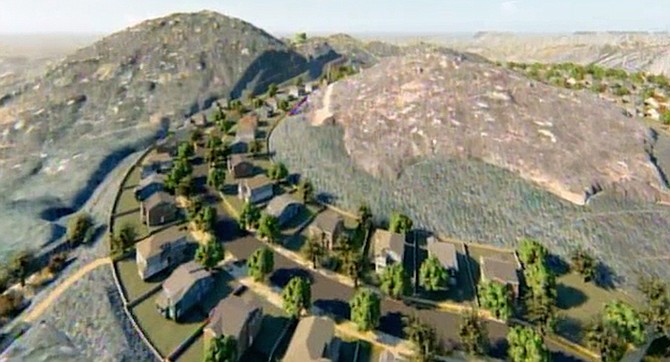
To North Country residents living near Merriam Mountains, it feels like Dr. Frankenstein is bringing that monster back to life. A monster called urban sprawl the community chased out of their backcountry in 2010.
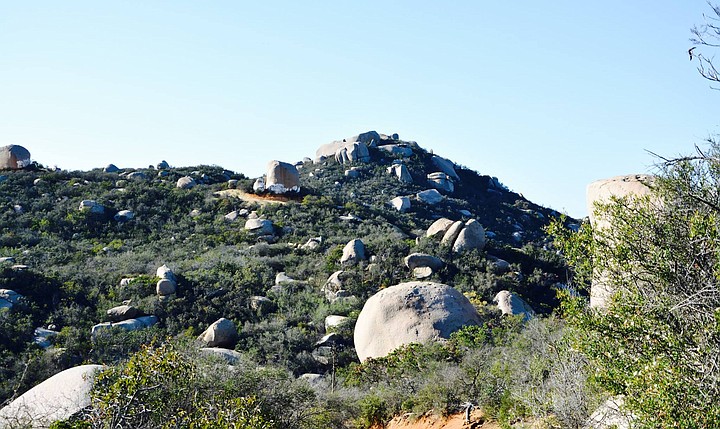
Back then, the mammoth housing development was called Merriam Mountains. It's now called Newland Sierra, but the opposition's pitchforks are jabbing at the same worries: density, traffic, wildfire evacuations, water, air quality, noise, views, greenhouse gas emissions, general plan amendments, and the matter of blasting apart a mountain range formed when dinosaurs still roamed the earth.
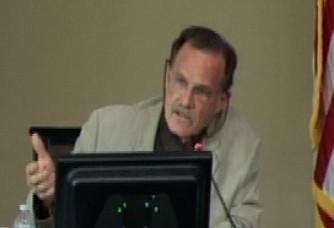
Abagail Henry, San Marcos native, started a Stop Newland Sierra Facebook page a couple years ago. She said Merriam Mountains are special to her and others who've gotten engaged there and who hold memorials for people and animals. "If you look closely, you can still see old Native American marks across the land, along with old rock carvings from passer-bys in the early 1900s."
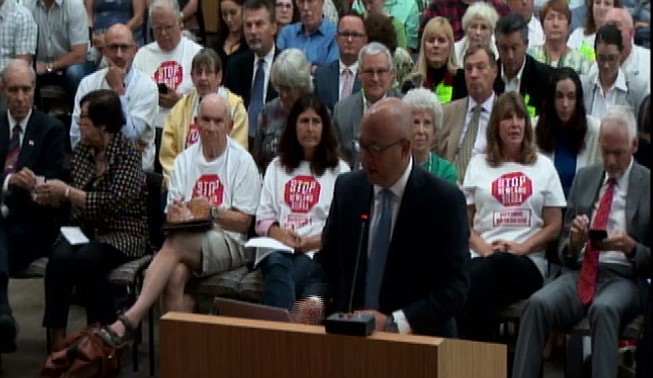
Henry said Twin Oaks Valley (San Marcos) residents are no strangers to blasting, having had "to endure blasting from two different rock quarries since the early-1980s." Residents say the worst of it is the fine dust that covers everything, making it difficult to breath.
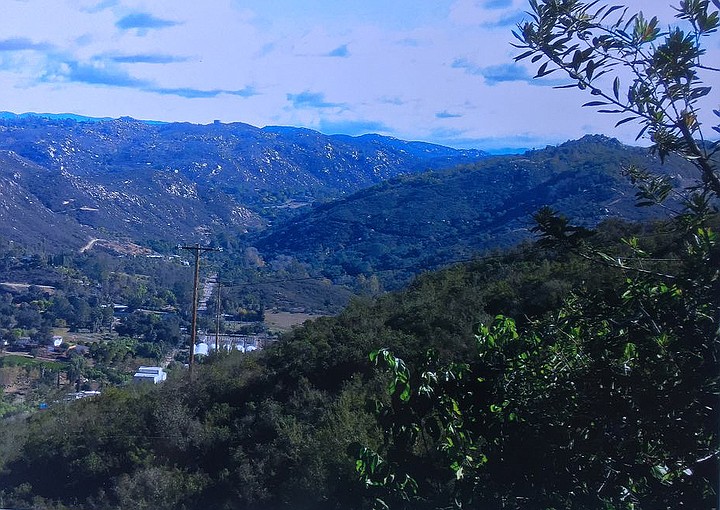
The proposed project within Merriam Mountains is along the I-15 corridor in San Marcos (unincorporated area), east of Vista and north of Escondido, sandwiched between the communities of Twin Oaks Valley and Hidden Meadows.

Kathe Robbins, a retired teacher, lives 1.2 miles away and can view the hilltops where Newland Sierra homes are proposed. She moved to Twin Oaks Valley in 1985 to live in a more rural setting to raise her children and to grow her own food. "We traded convenience for space." Robbins said this is the third time in thirty years a developer has come to "carve out giant pieces of our granite mountain" to develop "a new city the size of Del Mar."
Robbins' main concerns are the destruction of the mountain that hundreds of wildlife call home (county staff said blasting will take five years), how approving this project ignores the county's 2011 general plan (that down-zoned Merriam Mountains), and how the developer is not building the needed infrastructure before building homes.
As Robbins was gearing up for battle at the September 26 county board of supervisor's hearing, she received some welcome news on September 13. A superior court judge issued a stay on the approval of projects in unincorporated areas of San Diego that rely on offsetting greenhouse gas emissions with purchased carbon credits from out of the country. The lawsuit was filed by the Sierra Club and Golden Door (luxury spa across from project).
February 2018 guidelines (part of the county's climate action plan) state that projects requiring general plan amendments, that might intensify greenhouse gas emissions, are allowed to purchase carbon offset credits to make up for any emissions they can't manage with onsite design and mitigation. Opponents say the county's claim to be a leader in fighting climate change doesn't jive with paving urban sprawl with tens of millions in carbon credits.
Newland Sierra has touted their project as the county's "first carbon neutral community." Their technical report points to carbon credits. While these credits don't change the actual environmental impacts to a community, it allows Newland to legally make the "carbon neutral" claim.
At June's planning commission hearing, commissioner Michael Beck asked county staff about greenhouse emission policies that "require mitigation to occur in the county." Staff said they didn't interpret the policy to mean that all emissions need to be mitigated within the county.
Beck replied, "So the policy doesn't say what I read it to say and that is that you need to mitigate in the county? That policy doesn't say that?" Staff replied, "That's not the way the county interprets that policy. No."
The next court date for the carbon credits lawsuit is December 21, leaving some to wonder if Newland Sierra's upcoming hearing will be rescheduled. Developers likely have the votes with the current make-up of the board.
The future is less certain with two long-serving supervisors termed out this year (Bill Horn and Ron Roberts) and two more termed out in 2020 (Greg Cox and Dianne Jacob).
Two Republican candidates vying for supervisor seats in 2018 are likely to vote Newland's way (former district attorney Bonnie Dumanis and San Marcos mayor Jim Desmond), while two Democrat candidates are less certain to (former state assembly member Nathan Fletcher and legislative analyst Michelle Gomez).
Dumanis and Fletcher are vying for Roberts' seat and Desmond and Gomez are vying for Horn's seat. Desmond is Horn's pick to replace him and both Desmond and Dumanis are endorsed by the building industry association or BIA. At a February BIA event, Dumanis said she would not support an initiative requiring countywide public voting for general plan amendments in unincorporated areas (think Lilac Hills). This initiative is likely to be on the 2020 ballot.
Rita Brandin of Newland (Newland Sierra front-person) is vice chair of the BIA PAC (consists mostly of homebuilders) that endorses Desmond and Dumanis and doesn't support statewide measure Proposition 10 or a local measure in National City (rent control).
In July, supervisors unanimously voted through (Jacob absent) one bundle of three projects (3,850 homes) south of Newland Sierra in San Dieguito (Harmony Grove and Valliano) and in Otay Mesa (Otay 250).
The county is bundling these large projects because they're only allowed to amend the general plan four times a calendar year (bundled projects count as one amendment). Watching planning commissioner David Pallinger and county development services director hash this out on video, it sounded like a loophole to me. A lawsuit was reportedly filed against the board of supervisors about this.
If the board votes through Newland Sierra (2135 homes) in September and in December votes through another bundle (Lilac Hills, Warner Ranch, and Otay Ranch Village: 4056 homes), that will be 10,000 homes approved in three hearings. Voters defeated Lilac Hills in 2016.
June's planning commission hearing was a preview of the tug-of-war likely to play out at September's supervisors hearing. Proponents tried to distance Newland Sierra from the 2010 version of the project by repeatedly stating, "This is not the Merriam Mountains project."
While it may not technically be the same project, Newland Communities appears to have been involved in Merriam Mountains since at least 2004. State filings show Newland Sierra LLC started out as NNP-Stonegate Merriam LLC
In September 2016, LLC registration was completed by adding member name Nash-Newland Segregated LLC. Nash Communities is the North American arm of Japan's largest homebuilder, Sekisui House. In 2009, Sekisui expanded into Australia and Russia before expanding into China and the United States in 2010.
This is when Newland formed a joint venture with the Japanese goliath. In 2012, Newland made their third acquisition with Nash (Sekisui) that included 28 master-planned communities in the U.S., including three local Newland communities (4S Ranch, Merriam Mountain, Torrey Hills).
A side-by-side comparison of the two projects shows Newland Sierra has 7-percent less density, 15-percent less acreage (1985 versus 2237), and 21 percent fewer dwelling units (2135 versus 2700). The county's general plan zones this parcel for 99 houses and commercial/office space.
Newland Sierra is keeping 61 percent of the parcel as open space (10 percent more than Merriam Mountains) but has 40 percent fewer parks (36) than Merriam Mountains (89).
Brandin said homes will be priced $343,000 to $984,000 and include 1140 single-family homes (3500-7500 square foot lots) and 995 multi-family units with 81,000 square feet of office/retail space. Construction is expected to take a decade.
Newland appears to be selling off parcels to builders. Their project website tells future homebuyers that buying a home from a homebuilder on the Newland Sierra site waives any claims against Newland or Sekisui arising out of that purchase.
They state work of team members that created the environmental documentation (that convinced county staff and most of the county's planning commission to recommend their project forward) is "not guaranteed by Newland."
County planning commissioners voted in June to recommend the project forward to the board of supervisors with only minor changes.
At June's hearing, proponents consisted largely of those working in or around the building industry (developers, realtors, consultants, etc). This is likely because the building industry association or BIA's Project Green Light organizes members to flood hearings in support of fellow member's projects. Newland Sierra is highlighted on their website asking members to attend the supervisors' hearing to support Newland Sierra.
Opponents consisted of nearby residents and nearby businesses (mostly the Golden Door) concerns about wildfire evacuations, traffic, and the environment. Proponents' drumbeat included the housing crisis and the project being the only hope for infrastructure repair.
Newland's traffic consultant was asked about mitigation on a certain road. At one point, he threw up his hands and said, "They just have to mitigate the impact due to this project, not bring it back to level of service D." Levels of service are ranked from A (best) to F (worst). If approved, the project will do some roadway improvements, the most significant being to Deer Springs Road (two-lanes to four, I-15 to Twin Oaks Valley).
Opponents are not convinced Newland's roadway remedies will be enough and say that taxpayers will end up footing the bill for their project impacts. A point bolstered by Newland backing failed Prop A (2016) to hike sales tax to pay for much needed infrastructure.
Before the planning commission vote, Beck (only no vote) said, "So, we're planning for gridlock basically, is what we're doing."
At the Merriam Mountains board of supervisor's hearing in 2010, county staff seemed unprepared to respond to Jacob's questions about their water assessment, which included conservation projections that made the math work out a little too cute.
A proponent at June's hearing declared, "we have plenty of water to go around." Someone might want to alert those throwing billions into Pure Water (toilet-to-tap) and Governor Jerry Brown who signed two laws in 2018 requiring cities and water districts to set permanent water conservation rules and strict water budgets, even in non-drought years.
The county chose to exempt Newland Sierra from the resources protection ordinance (protects sensitive lands). When Beck asked why, his question was met with uncomfortable silence until staff said they wouldn't be able to approve the project if they didn't exempt it from the ordinance (too many encroachments into wetlands and steep slopes that would not be allowed under the ordinance permitting process).
Beck sounded stunned at the county's logic of bending to the project instead of asking the project to bend to the ordinance, by perhaps reducing their parameters. "It's depressing."
As far as how the supervisors might vote on Newland Sierra, there are clues from the 2010 hearings on Merriam Mountains as four of five supervisor's voting then are still on the board. Horn and Cox supported the project and are likely to vote the same in 2018.
Jacob and Roberts voted no, partly because of issues with greenhouse gas emissions and density. These issues are still in play in 2018.
Kristin Gaspar, the newest supervisor (took her seat in 2017), may cast the deciding vote. Perhaps something can be gleaned from her appointing Michael Edwards (former planning commissioner and land use attorney defending architects and engineers) to replace Peder Norby (no vote on Merriam Mountains and general plan literalist) on the planning commission.


To North Country residents living near Merriam Mountains, it feels like Dr. Frankenstein is bringing that monster back to life. A monster called urban sprawl the community chased out of their backcountry in 2010.

Back then, the mammoth housing development was called Merriam Mountains. It's now called Newland Sierra, but the opposition's pitchforks are jabbing at the same worries: density, traffic, wildfire evacuations, water, air quality, noise, views, greenhouse gas emissions, general plan amendments, and the matter of blasting apart a mountain range formed when dinosaurs still roamed the earth.

Abagail Henry, San Marcos native, started a Stop Newland Sierra Facebook page a couple years ago. She said Merriam Mountains are special to her and others who've gotten engaged there and who hold memorials for people and animals. "If you look closely, you can still see old Native American marks across the land, along with old rock carvings from passer-bys in the early 1900s."

Henry said Twin Oaks Valley (San Marcos) residents are no strangers to blasting, having had "to endure blasting from two different rock quarries since the early-1980s." Residents say the worst of it is the fine dust that covers everything, making it difficult to breath.

The proposed project within Merriam Mountains is along the I-15 corridor in San Marcos (unincorporated area), east of Vista and north of Escondido, sandwiched between the communities of Twin Oaks Valley and Hidden Meadows.

Kathe Robbins, a retired teacher, lives 1.2 miles away and can view the hilltops where Newland Sierra homes are proposed. She moved to Twin Oaks Valley in 1985 to live in a more rural setting to raise her children and to grow her own food. "We traded convenience for space." Robbins said this is the third time in thirty years a developer has come to "carve out giant pieces of our granite mountain" to develop "a new city the size of Del Mar."
Robbins' main concerns are the destruction of the mountain that hundreds of wildlife call home (county staff said blasting will take five years), how approving this project ignores the county's 2011 general plan (that down-zoned Merriam Mountains), and how the developer is not building the needed infrastructure before building homes.
As Robbins was gearing up for battle at the September 26 county board of supervisor's hearing, she received some welcome news on September 13. A superior court judge issued a stay on the approval of projects in unincorporated areas of San Diego that rely on offsetting greenhouse gas emissions with purchased carbon credits from out of the country. The lawsuit was filed by the Sierra Club and Golden Door (luxury spa across from project).
February 2018 guidelines (part of the county's climate action plan) state that projects requiring general plan amendments, that might intensify greenhouse gas emissions, are allowed to purchase carbon offset credits to make up for any emissions they can't manage with onsite design and mitigation. Opponents say the county's claim to be a leader in fighting climate change doesn't jive with paving urban sprawl with tens of millions in carbon credits.
Newland Sierra has touted their project as the county's "first carbon neutral community." Their technical report points to carbon credits. While these credits don't change the actual environmental impacts to a community, it allows Newland to legally make the "carbon neutral" claim.
At June's planning commission hearing, commissioner Michael Beck asked county staff about greenhouse emission policies that "require mitigation to occur in the county." Staff said they didn't interpret the policy to mean that all emissions need to be mitigated within the county.
Beck replied, "So the policy doesn't say what I read it to say and that is that you need to mitigate in the county? That policy doesn't say that?" Staff replied, "That's not the way the county interprets that policy. No."
The next court date for the carbon credits lawsuit is December 21, leaving some to wonder if Newland Sierra's upcoming hearing will be rescheduled. Developers likely have the votes with the current make-up of the board.
The future is less certain with two long-serving supervisors termed out this year (Bill Horn and Ron Roberts) and two more termed out in 2020 (Greg Cox and Dianne Jacob).
Two Republican candidates vying for supervisor seats in 2018 are likely to vote Newland's way (former district attorney Bonnie Dumanis and San Marcos mayor Jim Desmond), while two Democrat candidates are less certain to (former state assembly member Nathan Fletcher and legislative analyst Michelle Gomez).
Dumanis and Fletcher are vying for Roberts' seat and Desmond and Gomez are vying for Horn's seat. Desmond is Horn's pick to replace him and both Desmond and Dumanis are endorsed by the building industry association or BIA. At a February BIA event, Dumanis said she would not support an initiative requiring countywide public voting for general plan amendments in unincorporated areas (think Lilac Hills). This initiative is likely to be on the 2020 ballot.
Rita Brandin of Newland (Newland Sierra front-person) is vice chair of the BIA PAC (consists mostly of homebuilders) that endorses Desmond and Dumanis and doesn't support statewide measure Proposition 10 or a local measure in National City (rent control).
In July, supervisors unanimously voted through (Jacob absent) one bundle of three projects (3,850 homes) south of Newland Sierra in San Dieguito (Harmony Grove and Valliano) and in Otay Mesa (Otay 250).
The county is bundling these large projects because they're only allowed to amend the general plan four times a calendar year (bundled projects count as one amendment). Watching planning commissioner David Pallinger and county development services director hash this out on video, it sounded like a loophole to me. A lawsuit was reportedly filed against the board of supervisors about this.
If the board votes through Newland Sierra (2135 homes) in September and in December votes through another bundle (Lilac Hills, Warner Ranch, and Otay Ranch Village: 4056 homes), that will be 10,000 homes approved in three hearings. Voters defeated Lilac Hills in 2016.
June's planning commission hearing was a preview of the tug-of-war likely to play out at September's supervisors hearing. Proponents tried to distance Newland Sierra from the 2010 version of the project by repeatedly stating, "This is not the Merriam Mountains project."
While it may not technically be the same project, Newland Communities appears to have been involved in Merriam Mountains since at least 2004. State filings show Newland Sierra LLC started out as NNP-Stonegate Merriam LLC
In September 2016, LLC registration was completed by adding member name Nash-Newland Segregated LLC. Nash Communities is the North American arm of Japan's largest homebuilder, Sekisui House. In 2009, Sekisui expanded into Australia and Russia before expanding into China and the United States in 2010.
This is when Newland formed a joint venture with the Japanese goliath. In 2012, Newland made their third acquisition with Nash (Sekisui) that included 28 master-planned communities in the U.S., including three local Newland communities (4S Ranch, Merriam Mountain, Torrey Hills).
A side-by-side comparison of the two projects shows Newland Sierra has 7-percent less density, 15-percent less acreage (1985 versus 2237), and 21 percent fewer dwelling units (2135 versus 2700). The county's general plan zones this parcel for 99 houses and commercial/office space.
Newland Sierra is keeping 61 percent of the parcel as open space (10 percent more than Merriam Mountains) but has 40 percent fewer parks (36) than Merriam Mountains (89).
Brandin said homes will be priced $343,000 to $984,000 and include 1140 single-family homes (3500-7500 square foot lots) and 995 multi-family units with 81,000 square feet of office/retail space. Construction is expected to take a decade.
Newland appears to be selling off parcels to builders. Their project website tells future homebuyers that buying a home from a homebuilder on the Newland Sierra site waives any claims against Newland or Sekisui arising out of that purchase.
They state work of team members that created the environmental documentation (that convinced county staff and most of the county's planning commission to recommend their project forward) is "not guaranteed by Newland."
County planning commissioners voted in June to recommend the project forward to the board of supervisors with only minor changes.
At June's hearing, proponents consisted largely of those working in or around the building industry (developers, realtors, consultants, etc). This is likely because the building industry association or BIA's Project Green Light organizes members to flood hearings in support of fellow member's projects. Newland Sierra is highlighted on their website asking members to attend the supervisors' hearing to support Newland Sierra.
Opponents consisted of nearby residents and nearby businesses (mostly the Golden Door) concerns about wildfire evacuations, traffic, and the environment. Proponents' drumbeat included the housing crisis and the project being the only hope for infrastructure repair.
Newland's traffic consultant was asked about mitigation on a certain road. At one point, he threw up his hands and said, "They just have to mitigate the impact due to this project, not bring it back to level of service D." Levels of service are ranked from A (best) to F (worst). If approved, the project will do some roadway improvements, the most significant being to Deer Springs Road (two-lanes to four, I-15 to Twin Oaks Valley).
Opponents are not convinced Newland's roadway remedies will be enough and say that taxpayers will end up footing the bill for their project impacts. A point bolstered by Newland backing failed Prop A (2016) to hike sales tax to pay for much needed infrastructure.
Before the planning commission vote, Beck (only no vote) said, "So, we're planning for gridlock basically, is what we're doing."
At the Merriam Mountains board of supervisor's hearing in 2010, county staff seemed unprepared to respond to Jacob's questions about their water assessment, which included conservation projections that made the math work out a little too cute.
A proponent at June's hearing declared, "we have plenty of water to go around." Someone might want to alert those throwing billions into Pure Water (toilet-to-tap) and Governor Jerry Brown who signed two laws in 2018 requiring cities and water districts to set permanent water conservation rules and strict water budgets, even in non-drought years.
The county chose to exempt Newland Sierra from the resources protection ordinance (protects sensitive lands). When Beck asked why, his question was met with uncomfortable silence until staff said they wouldn't be able to approve the project if they didn't exempt it from the ordinance (too many encroachments into wetlands and steep slopes that would not be allowed under the ordinance permitting process).
Beck sounded stunned at the county's logic of bending to the project instead of asking the project to bend to the ordinance, by perhaps reducing their parameters. "It's depressing."
As far as how the supervisors might vote on Newland Sierra, there are clues from the 2010 hearings on Merriam Mountains as four of five supervisor's voting then are still on the board. Horn and Cox supported the project and are likely to vote the same in 2018.
Jacob and Roberts voted no, partly because of issues with greenhouse gas emissions and density. These issues are still in play in 2018.
Kristin Gaspar, the newest supervisor (took her seat in 2017), may cast the deciding vote. Perhaps something can be gleaned from her appointing Michael Edwards (former planning commissioner and land use attorney defending architects and engineers) to replace Peder Norby (no vote on Merriam Mountains and general plan literalist) on the planning commission.
Comments